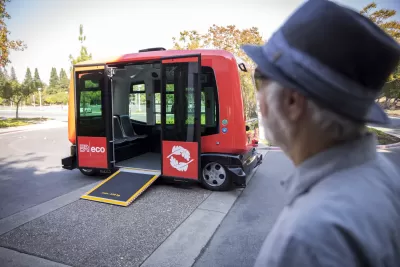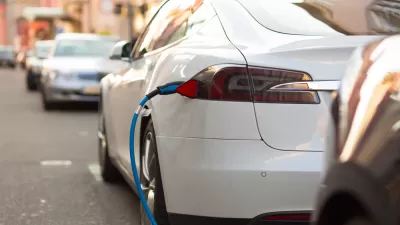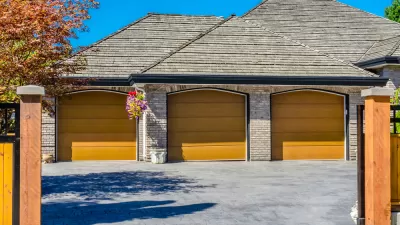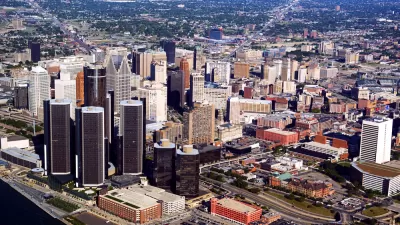Guest contributor Marco Anderson maps out a role for planners in preparing for an era of shared, automated, and zero-emissions mobility technology.

The era of individually owned, gas-powered cars driven by human beings might be drawing to a close. A new age of shared, zero-emission, automated vehicles is likely emerging. Best-case scenario: we end up with cleaner air, better-connected communities, and an expansion of accessible and affordable mobility options for all. Worst-case scenario: we end up with more sprawl and pollution as people are willing to travel farther in their cushy driverless cars.
Planners will play a key role in determining whether our transportation future is bright or nightmarish. Absent policy reform, this new era could contribute to more sprawl, but a sustainable planning approach that supports both higher-density development and lower single-occupant (or zero-occupant) driving could also put people first, before cars.
The 3 Revolutions Policy Initiative at the University of California Davis’ Institute of Transportation Studies recently released a policy brief on "Land Use Planning and Transportation Policies" to summarize the actions planners can take to embrace the transportation revolutions.
Findings
The following findings highlight the interconnected land use and transportation impacts of the three transportation revolutions:
Automation – Current research and modeling indicates that if automation technologies are deployed in an unfettered market setting, reductions in trip time and cost will likely increase single-occupant (and potentially zero-occupant) vehicle travel, increase trip distances, and shift trips away from transit. Because passengers will be able to communicate, work, and even rest in their cars, autonomous vehicles may accelerate sprawl by increasing the distances people are willing to commute [pdf].
Shared Mobility – The introduction of shared mobility services, such as ride-hailing, car-sharing, and bikesharing, has already started to revolutionize the way we travel. As more adoption occurs, these services could potentially affect vehicle ownership rates and the use of other modes of transportation, among other effects. Street level pick-up and drop-off design, parking, roadway funding models, will soon require updating as multimodal shared mobility services gain mode share.
Electrification – Widespread adoption of electric vehicles may contribute to changing land use patterns and driving behaviors among electric vehicle users. This shift will also increase the need for electric vehicle charging infrastructure.
Convergence of "The 3 Revolutions" – The 3 Revolutions brief aims to identify a sustainable path forward. Through the convergence of shared mobility, automation, and electrification, there is the potential to mitigate the negative externalities of 20th century auto-oriented sprawl, negate any additional sprawl associated with automation, and provide rapid responses to enable sharing and electrification.
Policy Recommendations
When it comes to public policy solutions, conversations with technologists and automakers can be frustrating. On the one hand, planners hear that their modeling and design paradigms are outdated, and they are unprepared for these radical changes. On the other hand, decision-makers are warned that any regulations will stymie innovation. First, signs seem to point to staying the course on sustainable planning. Many of the best practices already being used to mitigate the impacts of auto-oriented sprawl will likely be even more essential to curb autonomous-vehicle-induced sprawl.
And it will be more important than ever for savvy planners to use the right tools to achieve sustainable planning goals.
The 3 Revolutions policy brief focuses on a suite of recommendations, including:
- Price mobility to maintain roadways: While some public officials dream about high-tech infrastructure, for developers of shared, electric, autonomous vehicles, their priority remains smooth, clean, well-painted roadways. Gas tax revenues cannot be anticipated to keep up. New mobility pricing schemes that allow revenues to be generated according to vehicle miles traveled, vehicle size, and occupancy will allow communities to better match travel with societal costs.
- Price open space and encourage compact communities: It is possible that reductions in time and cost burdens of driving will lead to households moving farther away from workplaces and other typical travel destinations. Planning that redoubles financial incentives for compact infill growth and disincentivizes urban fringe development may be able to offset this trend.
- Price parking and revamp to encourage sharing: Parking fees will continue to impact travel choices, and will be a critical tool in discouraging individual travel and encouraging sharing. Also essential are efforts to replace obsolete parking [pdf] with active use zones, and to replace street parking with pick-up/drop-off areas that encourage shared mobility.
As we contemplate a dramatically different future where people share electric automated vehicles, countless other planning considerations will also arise.
Opportunities for Future Research
Transportation behavior and modeling research needs include the following:
Invest in experimentation for regional public sector partners: Regional and local land use and transportation agencies are being asked to plan for an uncertain future. Funding is needed to update their scenario planning tools. Currently, most transportation planning models employ aggregated travel demand models and statistical analysis techniques that rely on historical data derived from years of observation and household travel survey responses.
Regional transportation agencies across the country are experimenting with these computer models to better simulate the types of revolutionary changes in three revolutions travel, root their updates in the newest findings from travel behavior studies, and improve the ability of models to simulate real human behavior. However, this experimentation can be expensive, time consuming, require coordination with other researchers and transportation experts, and often does not receive enough resources in terms of staff and budget allocation.[1]
Expand travel and economic behavior research beyond travel demand models: First, it will be important to better understand how people react to changes in travel options, and how this impacts their long-term (e.g. residential location), medium-term (e.g. vehicle ownership) and short-term (e.g. daily travel behavior, activity participation, mode choice, route choice, etc.) choices.
Therefore, a continued research effort is needed to identify the potential changes associated with the introduction and adoption of new mobility services, through the coordination of dedicated data collections (including the collection of revealed preferences and individuals’ attitudes and preferences). This could include creative behavioral experiments, stated preferences studies, use of virtual and augmented reality, activity-based modeling and travel forecasting improvement, scenario modeling and microsimulation studies.
Micro-level simulation to determine street level pick-up drop-off designs: In addition to the regional travel demand modeling needed to understand overall travel patterns, urban planners need experimental data on how various autonomous vehicles will perform on city streets and roads. Most of the micro-simulations used to date demonstrate freeway driving conditions. However, some urban design decisions that will need to be made over the coming years involve regulation of on-street parking, and pick-up and drop-off zones for shared autonomous vehicles. Research is needed to identify how these zones interact with other policy priorities like increasing bike lanes in urban environments or prioritizing transit-only lanes. Micro simulations should also be applied to the role that vehicle automation will play in urban delivery systems.
Economic cost-benefit analysis: To evaluate societal considerations surrounding vehicle automation and locational choices, a full cost-benefit analysis is required. This will include evaluation of societal costs of additional driving miles, and specific quantification of any new or differing costs associated with zero-passenger miles.
Central to this type of analysis is also a quantification of the equity and environmental justice costs associated with an increase in autonomous vehicles on the roadways. The following considerations are a starting place to identify the types of societal costs and benefits. Further investigation is needed but these deserve mention:
Labor: Automating driving will impact millions of professional drivers in the logistics and transit industries, and these jobs provide a reliable source of income to many working-class members of society.
Accessibility: The extent to which shared autonomous vehicles also have the potential to connect low-income households to previously unreachable employment opportunities. It is important to focus on mitigating the negative impacts, but research is needed to determine the economic benefits that may come from increased mobility for low-income workers.
Planners' expertise and abilities in envisioning where communities want to go and figuring out how they can get there will be invaluable in charting a better transportation future.
This policy brief is only the beginning of the conversation. We need continued research efforts to identify potential changes associated with the introduction and adoption of new mobility services, through coordinated and dedicated data collections (including the collection of revealed preferences and individuals’ attitudes and preferences). Research could include creative behavioral experiments; stated preferences studies; use of virtual and augmented reality, activity-based modeling and travel forecasting improvement, and scenario modeling and microsimulation studies.
Properly channeled, the three transportation revolutions can make our communities stronger. But it will take the steadfast support of strategic planners, using our best available tools, to achieve our best-case transportation future.
 Marco Anderson is a program manager with the Southern California Association of Governments (SCAG).
Marco Anderson is a program manager with the Southern California Association of Governments (SCAG).
[1] Fagnant J., Daniel, Kara Kocklema. “Preparing a nation for autonomous vehicles: opportunities, barriers and policy recommendations.” Transportation Research Part A, July 2015, doi:10.1016/j.tra.2015.04.003

Planetizen Federal Action Tracker
A weekly monitor of how Trump’s orders and actions are impacting planners and planning in America.

Maui's Vacation Rental Debate Turns Ugly
Verbal attacks, misinformation campaigns and fistfights plague a high-stakes debate to convert thousands of vacation rentals into long-term housing.

Restaurant Patios Were a Pandemic Win — Why Were They so Hard to Keep?
Social distancing requirements and changes in travel patterns prompted cities to pilot new uses for street and sidewalk space. Then it got complicated.

In California Battle of Housing vs. Environment, Housing Just Won
A new state law significantly limits the power of CEQA, an environmental review law that served as a powerful tool for blocking new development.

Boulder Eliminates Parking Minimums Citywide
Officials estimate the cost of building a single underground parking space at up to $100,000.

Orange County, Florida Adopts Largest US “Sprawl Repair” Code
The ‘Orange Code’ seeks to rectify decades of sprawl-inducing, car-oriented development.
Urban Design for Planners 1: Software Tools
This six-course series explores essential urban design concepts using open source software and equips planners with the tools they need to participate fully in the urban design process.
Planning for Universal Design
Learn the tools for implementing Universal Design in planning regulations.
Heyer Gruel & Associates PA
JM Goldson LLC
Custer County Colorado
City of Camden Redevelopment Agency
City of Astoria
Transportation Research & Education Center (TREC) at Portland State University
Jefferson Parish Government
Camden Redevelopment Agency
City of Claremont





























